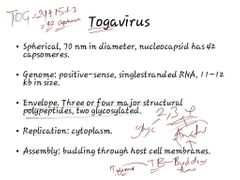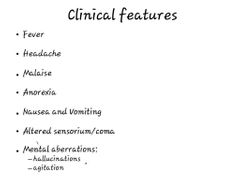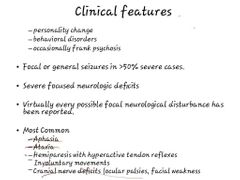![]()
![]()
![]()
Use LEFT and RIGHT arrow keys to navigate between flashcards;
Use UP and DOWN arrow keys to flip the card;
H to show hint;
A reads text to speech;
29 Cards in this Set
- Front
- Back
|
The most common causes of meningitis are |
Viruses |
|
|
What is aseptic meningitis |
It is the presence of evidence of meningitis, but with negative gram stain or bacteria culture |
|
|
Mention the causes of viral meningitis |
● Enterovirus (Echovirus and Coxsackie virus) ● Herpes Simplex virus (HSV 1 and 2) ● Cytomegalovirus ● Varicella Zoster virus ● HIV ● Mumps virus ● Measles ● Dengue virus ● West Nile virus |
|
|
The most common cause of viral aseptic meningitis is |
Enteroviruses |
|
|
Enteroviral meningitis are common in what age group |
In children |
|
|
Most enteroviral are self-limiting. T/F |
TRUE (they are), though they cause significant death and diseases in neonates. |
|
|
Highest incidence of enteroviral meningitis is seen in when |
Summer/autumn in temperate regions |
|
|
Enteroviruses can occur as epidemic meningitis. T/F |
True, they can |
|
|
Enteroviruses are transmitted how? |
Feco-oral routes. (That's why they are called "enterovirus", they get in through the enteron/GI) |
|
|
Viruses get into the CNS by 3 major means. Mention them |
● Through blood (crossing BBB directly) ● Along the peripheral nerves (eg Polio virus) ● Carried across BBB by infected phagocytes |
|
|
When the viruses invade the CNS, how do they spread around it |
● Through the CSF (they circulate to all parts of the cns) ● Through the leukocytes they infected that also circulate the cns |
|
|
Mention the symptoms of meningitis |
● Fever (inflammation) ● Headaches ● Head and Neck stiffness ● Photophobia ● Rash ● Convulsion (uncommon) ● Nausea and Vomitting |
|
|
What signs are in meningitis |
● Kernig's sign ● Brudsinski sign |
|
|
Laboratory specimen collected for diagnosing meningitis |
● CSF ● Blood ● Stool (for viruses like enterovirus) ● Throat swab |
|
|
Lumbar puncture for CSF collection is done at |
L3/L4 vertebrae |
|
|
Normal CSF protein and glucose are |
CSF glucose= 50-75 mg/dL CSF protein= 15-40 mg/dL |
|
|
What cell infiltrates are abundant in bacterial vs viral meningitis |
● Bacterial meningitis = Polymorphonuclear cells (neutrophils, macrophages) ● Viral meningitis = Lymphocytes |
|
|
Antiviral drug for HSV |
Acyclovir |
|
|
The most common causes of Encephalitis are |
Viruses (just like for meningitis) |
|
|
Causes of viral encephalitis |
● Herpes virus ● Flaviviridae (West Nile, Japanese encephalitis) ● Togaviridae (Eastern, Western equine encephalitis) ● Enterovirus ● Measles virus ● Mumps virus ● Rabies virus ● Influenza virus ● Adenovirus ● Colorado tick fever virus |
|
|
What are general features of arboviruses |
● Enveloped, ssRNA viruses (eg Flavivirus) |
|
|
The reservoirs of arboviruses are |
● "Wild birds and small mammals" (whose blood with virus get sucked by the arthropods and transmitted to humans) |
|
|
Characteristics of Flaviviridae |
● Spherical, 40-60nm in diameter ● Enveloped, ssRNA, positive sense virus ● Has 3 structural proteins (Capsid, Membrane and Envelope protein) ● Has Non-structural proteins : NS1, NS2A, NS2B, NS3, NS4A, NS4B, NS5 ● Replicates in the Cytoplasm ● Assembly in the Endoplasmic recticulum |
|
|
Features of Togavirus |

|
|
|
In encephalitis, there are focal or generalized seizures in how many percent of cases |
>50% of cases |
|
|
Clinical features of Encephalitis |

|
|
|
Clinical features of Encephalitis (cont'd) |

|
|
|
Laboratory diagnosis of encephalitis |
It is similar to meningitis |
|
|
Which 2 viral encephalitis have HIGH MORTALITY RATES |
Eastern Equine Encephalitis (EEE) and St. Louis Encephalitis |

